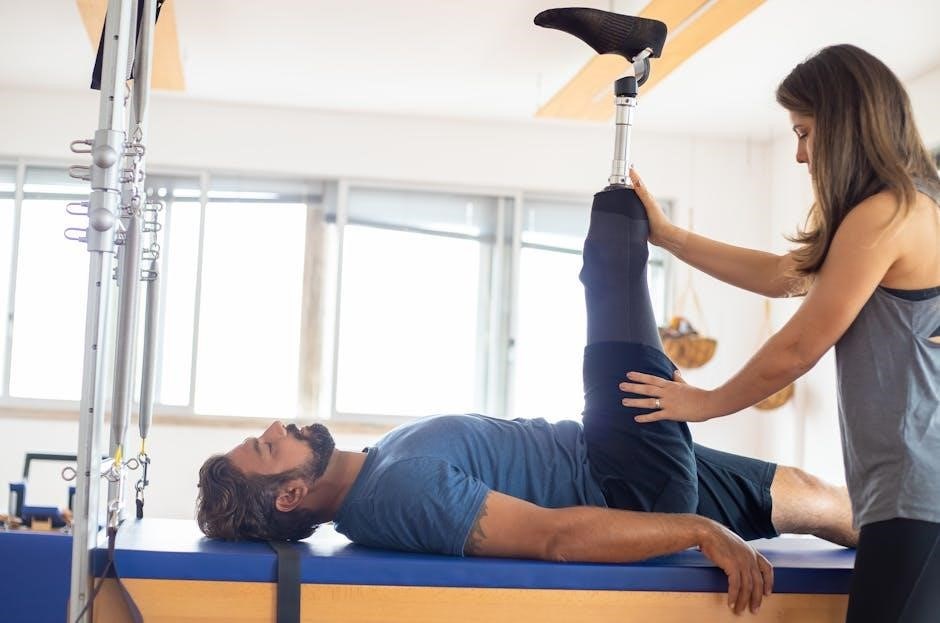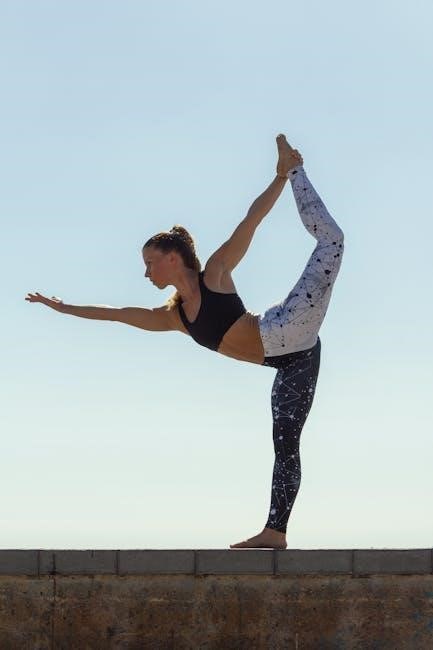Shin splints, or medial tibial stress syndrome, cause pain in the lower leg, often affecting runners and those with repetitive physical activity. While treatable, they can be frustrating. This guide provides effective stretches and exercises to alleviate symptoms and promote recovery.

Causes and Symptoms of Shin Splints
Shin splints result from overuse, improper footwear, or running on hard surfaces, causing pain along the shinbone, mild swelling, and soreness in the lower leg area.
Causes of Shin Splints
Shin splints, or medial tibial stress syndrome, are often caused by overuse, such as repetitive running or jumping, which strains the muscles and tendons in the lower leg. Improper footwear, running on hard surfaces, or sudden changes in exercise intensity can also contribute. Additionally, poor running technique, flat feet, or weak calf muscles may increase the risk. These factors lead to inflammation and pain along the shinbone, making it essential to address the root causes to prevent recurrence and promote healing.

Symptoms of Shin Splints
Shin splints typically cause a sharp or dull pain along the inner edge of the shinbone, often worsening during or after physical activity. Swelling and tenderness in the lower leg are common, and the area may feel warm to the touch. Pain can also radiate along the length of the shin, making it uncomfortable to walk or run. In severe cases, the discomfort may persist even at rest. Early symptoms often include mild soreness that intensifies with continued activity, while untreated cases can lead to chronic pain. Recognizing these symptoms early is crucial for effective treatment and preventing further complications.
Importance of Rest and Ice in Treatment
Rest and ice are crucial for reducing inflammation and pain in shin splints. Rest allows the body to heal, while ice minimizes swelling and alleviates discomfort effectively.
Benefits of Rest for Shin Splints
Rest is essential for healing shin splints as it allows the body to repair damaged tissues and reduce inflammation. Without adequate rest, the condition can worsen, leading to prolonged recovery. By avoiding high-impact activities, you prevent further strain on the shinbones and muscles. Rest also helps reduce muscle fatigue, which can contribute to poor running or walking mechanics. Incorporating rest into your treatment plan promotes tissue repair and strengthens the muscles around the shin, reducing the risk of recurrence. It’s a critical first step in managing shin splints effectively and safely returning to physical activities.
How to Use Ice for Shin Splints
Icing is a simple yet effective way to manage shin splint pain and inflammation. Wrap an ice pack or a bag of frozen peas in a towel to protect your skin. Apply the ice to the affected area for 15-20 minutes, 3-4 times daily. This helps reduce swelling and numbs the pain. Always place a barrier between the ice and skin to avoid frostbite. Icing is most beneficial in the acute phase of injury, as it constricts blood vessels and limits inflammation. Consistent icing can accelerate recovery and prepare the area for stretching and strengthening exercises. For best results, combine icing with rest and avoid activities that aggravate the condition.

Effective Stretches for Shin Splints
Targeted stretches can alleviate shin splint pain by improving flexibility and reducing muscle tension. Focus on calf, Achilles, and shin muscles to enhance recovery and prevent recurrence.
Calf Stretch

To perform a calf stretch, stand facing a wall with one hand on it for balance. Step one foot back about a foot, keeping your heel on the ground. Slowly bend the front knee, leaning forward until you feel a gentle stretch in the back of your calf. Hold for 20-30 seconds, then switch legs. This stretch targets the gastrocnemius and soleus muscles, which are often tight in shin splints. Regular stretching can reduce muscle tension and improve flexibility, helping to alleviate pain and prevent recurrence. Aim to do this stretch 2-3 times daily, ensuring deep breaths to maximize the stretch. Consistency is key to seeing improvement in shin health and overall lower leg mobility.
Step-Ups
Step-Ups are an effective exercise for addressing shin splints by strengthening the muscles around the shin and improving mobility. To perform this exercise, stand in front of a sturdy box or step. Step forward with the affected leg and place it flat on the box. Bring the other leg up to meet it, then step back down with the same leg you used to step up. Repeat this motion for 3 sets of 8-12 repetitions. As strength improves, gradually increase the height of the box. This exercise targets the shin muscles, helping to reduce pain and prevent recurrence. Consistency is key, as regular practice enhances muscle endurance and supports overall lower leg stability. Proper form is essential to avoid further strain and maximize the benefits of this exercise.
Soleus Squats
Soleus Squats are a valuable exercise for addressing shin splints, focusing on the lower calf and shin muscles. To perform this exercise, stand with your feet shoulder-width apart. Slowly lean forward, keeping your heels on the ground, until you feel a gentle stretch in the back of your calf. Hold this position for 15-30 seconds, then relax and take a deep breath. Repeat for 3 sets, performing 3 repetitions per leg daily. This exercise helps alleviate shin pain by stretching the soleus muscle, which runs along the back of the lower leg. Regular practice can improve flexibility and reduce tension in the shin area. Proper form is essential to avoid strain, so ensure your movements are controlled and deliberate. Over time, Soleus Squats can contribute to stronger, more resilient shin muscles, helping to prevent future episodes of shin splints.
Resisted Dorsiflexion
Resisted Dorsiflexion is an effective exercise for strengthening the muscles at the front of the shin, which can help prevent shin splints from recurring. To perform this exercise, sit on the floor with your legs straight out in front of you. Loop a resistance band around the ball of one foot, securing the other end to a stable object. Slowly flex your foot upward, pulling against the band, and hold for 5 seconds before releasing. Repeat this motion for 3 sets of 10-15 repetitions per leg. This exercise targets the tibialis anterior muscle, improving its strength and endurance. It’s important to start with light resistance and gradually increase as your strength improves. Proper form is key to avoiding strain, so focus on controlled movements. Resisted Dorsiflexion is a simple yet impactful way to support shin health and reduce the risk of future pain.

Tibialis Anterior Stretch
The Tibialis Anterior Stretch targets the muscle responsible for dorsiflexion, helping to alleviate shin splint pain. Stand tall with both feet flat on the floor. Bend both knees slightly, keeping one foot on the ground while curling the other foot upward toward your shin. Hold this position for 20-30 seconds, ensuring a gentle stretch in the front of your lower leg. Repeat this 2-3 times per leg. This stretch improves flexibility and reduces tension in the tibialis anterior muscle, which is often strained in shin splints. For enhanced effectiveness, take deep breaths during the stretch to relax the muscle further. Regular practice can help prevent recurrence and support overall shin health.
Strengthening Exercises for Shin Splints
Strengthening exercises like step-ups, soleus squats, and resisted dorsiflexion target the muscles around the shin, improving stability and reducing pain. Regular practice helps build strength and prevent recurrence.
Step-Ups

Step-ups are an effective exercise for strengthening the muscles around the shin, helping to alleviate shin splint pain. To perform a step-up, stand in front of a sturdy box or platform. Step forward with the affected leg and place it flat on the box. Bring the other leg up to meet it, then step back down with the same leg you used to step up. Repeat this process, gradually increasing the height of the box as your strength improves. Aim for 3 sets of 8-12 repetitions daily. This exercise targets the shin and calf muscles, improving stability and reducing the risk of recurrence. Proper form is essential to avoid injury, so keep your back straight and engage your core throughout the movement.
Soleus Squats
Soleus squats are a valuable exercise for addressing shin splints, targeting the soleus muscle in the lower calf. To perform this exercise, stand with your feet shoulder-width apart and slowly bend your knees, keeping your heels on the ground. Lean forward slightly, stretching the back of your calf, and hold for 15-30 seconds. Repeat for 3 sets, doing 3 repetitions per leg daily. This stretch helps relieve tension in the shin area and improves flexibility. It’s essential to maintain proper form, keeping your back straight and engaging your core to avoid strain. Soleus squats are particularly effective for runners or those with medial tibial stress syndrome, as they strengthen the muscles around the shin, reducing pain and preventing recurrence.
Resisted Dorsiflexion
Resisted dorsiflexion is an effective exercise for strengthening the muscles at the front of the shin, particularly the tibialis anterior. To perform this exercise, sit on the floor with your legs extended straight in front of you. Loop a resistance band or towel under the ball of one foot, holding the ends of the band in your hands. Slowly flex your foot upward, pulling against the resistance, and hold for 2-3 seconds before releasing. Repeat this motion for 3 sets of 10-15 repetitions on each leg. This exercise helps improve muscle strength and reduces the risk of shin splint recurrence. It’s important to start with minimal resistance and gradually increase as your strength improves. Consistency is key to seeing lasting benefits and preventing future injuries.
Preventing Shin Splints
Preventing shin splints involves a combination of proper footwear, consistent stretching, and avoiding overtraining. Incorporating rest days and strengthening exercises can significantly reduce the risk of recurrence.
Importance of Proper Footwear
Proper footwear plays a crucial role in preventing shin splints by providing adequate support and cushioning. Shoes with good arch support and shock absorption can reduce stress on the lower legs. Wearing shoes designed for your specific activity and foot type helps distribute pressure evenly, minimizing the risk of shin pain. Additionally, replacing worn-out shoes regularly is essential, as they lose their supportive properties over time. Improper footwear can lead to overpronation or supination, increasing the likelihood of shin splints. By investing in high-quality, activity-specific shoes, individuals can significantly lower their chances of developing this condition. Proper footwear, combined with gradual increases in activity, forms a strong foundation for shin splint prevention.

Role of Running Technique
Running technique significantly impacts the development and prevention of shin splints. Overpronation or supination can lead to uneven stress distribution, increasing the risk of shin pain. Factors such as stride length, posture, and foot strike pattern play a crucial role. A midfoot or forefoot strike, rather than a heel strike, can reduce stress on the shins. Additionally, excessive heel striking and poor running form can exacerbate the condition. Strengthening core and leg muscles, along with improving flexibility, can enhance running mechanics. Consulting a running coach or using gait analysis can help identify and correct improper techniques. Proper running form not only reduces the risk of shin splints but also improves overall performance and reduces injury risk. Addressing technique early can prevent chronic issues and promote long-term running health.

Yoga Stretches for Shin Health
Yoga stretches, like standing and seated shin stretches, target the tibialis anterior muscle, improving flexibility and reducing shin splint discomfort. Regular practice enhances circulation and strengthens the lower legs, promoting overall shin health and preventing future pain.
Standing Shin Stretch
The standing shin stretch is an effective yoga pose for targeting the tibialis anterior muscle, which runs along the front of the shin. To perform this stretch, stand tall with both feet flat on the floor, hip-width apart. Slowly bend both knees slightly, keeping your weight evenly distributed. As you bend, curl your toes under and lift the ball of your foot toward your shin. Hold this position for 15-20 seconds to feel a gentle stretch in the front of your lower leg. Repeat this exercise 3-5 times. This stretch improves flexibility, reduces tightness, and helps alleviate shin splint discomfort. Regular practice can also enhance circulation and strengthen the muscles around the shin, promoting overall lower leg health and reducing the risk of future pain.
Seated Shin Stretch
The seated shin stretch targets the tibialis anterior muscle, helping to relieve tension and pain associated with shin splints. Sit on the floor with your legs extended straight in front of you. Loop a towel or resistance band around the ball of one foot and gently pull your toes back toward your head. Hold the stretch for 15-20 seconds, then release. Repeat this 3-5 times for each leg. This stretch improves flexibility in the front of the shin and can help prevent future discomfort. It’s particularly beneficial for individuals who engage in activities like running or cycling, as it addresses tightness in the lower leg muscles. Regular practice can enhance circulation and reduce the risk of shin splints, making it a simple yet effective addition to your routine.

When to See a Professional
If experiencing severe pain, swelling, or limited mobility, consult a healthcare professional. Persistent symptoms may require medical intervention for proper diagnosis and treatment.
Knowing When to Seek Medical Help
It’s crucial to recognize when shin splint symptoms warrant professional attention. If pain persists despite rest and ice, or if swelling increases, consult a doctor. Severe pain during activities, numbness, or difficulty walking are red flags. A healthcare provider can rule out stress fractures or other serious conditions. They may recommend imaging tests like X-rays or MRIs for an accurate diagnosis. Early intervention prevents complications and ensures proper healing. Don’t ignore persistent symptoms, as untreated shin splints can lead to chronic issues. Seeking medical help when necessary ensures effective treatment and a faster return to normal activities.

